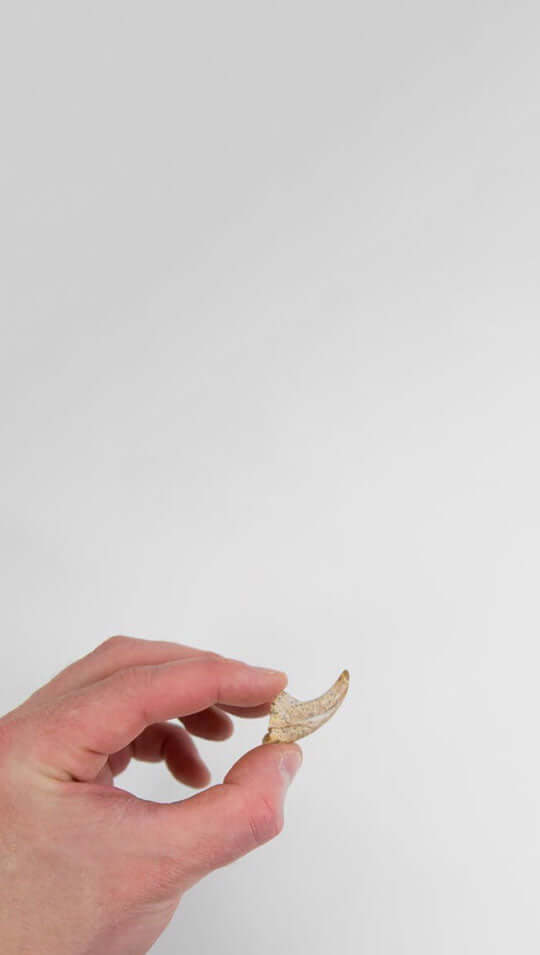We hope you enjoy perusing our web store and an insight into the fossils of the Western Desert...
Theropod Dinosaur Specimen Discoveries

Welcome to our dinosaur journal page where we have listed a few of our latest fossil finds of rare prehistoric dinosaur claws, teeth and bones here is a brief resume of what we have discovered and offered for sale on our web catalogue, we hope you enjoy perusing our web store and an insight into the fossils of the Western Desert.
Dromeosaurs are commonly referred to as 'Raptors', this was a trend when the Jurassic Park series of films entered our collective consciousness. Velociraptors featured in the first epic film terrorised everyone and captured our imaginations, here in this post we are taking a view on the actual and authentic Raptor teeth and claws of some of the Dromeosaurids of Africa, the differences in varied shapes and sizes and the location of finds.
The latter, which you can find on each item listing page on our web site, links to the relative sections can be obtained from the links below and image clicks.
It is believed the dromaeosaurids evolved during the Jurassic, to date teeth have been found in that age of fossil-bearing layer and we know they became extinct at the end of the Cretaceous period around 66 m.y.a. Finding good complete examples is difficult, thus dinosaur teeth are a rare commodity, especially when in a good state of preservation or even on very rare occasions in a nearly pristine condition.
Claws are even more rarely discovered than teeth, to find one in a near-complete or pristine condition is akin to an old prospector finding that elusive gold nugget. You may see in our selection a comprehensive, varied group of fossil teeth and some claws which have been collected over several years and only now for the first time, offered for sale. With some of our latest discoveries.
Dromaeosauridae 'running lizards', comes from Greek dromeus meaning 'runner' and sauros meaning 'lizard'. The naming of the 'Raptors' helps further describe the slender small sized teeth and fine claws, along with hollow and therefore lighter bones, in slender skeletal frame dromeosaurs were built for the flight not fight on an individual basis. A small to a medium-sized dinosaur, with feathers, theorists believe that many of these dinosaurs were pack animals, one could coin the term the wolves of the Mesozoic era.
When one thinks of dromaeosaurs or raptors, the large sickle killing claw (see image below), may be envisaged, this typifies the species of dromaeosaurs. Due to the fragility of the dromeosaurs bones, invariably many teeth are more often than not discovered broken or damaged in fossil layers, equally susceptible other dinosaur species fossils, teeth and claws are equally scarce to find in good state of preservation.
Terrestrial carnivore dinosaur fossil teeth are most often recognised by the archetypical triangular shark fin shape, fine serrations and enamel crowns. Our teeth here are no exception to this basic of rules for an efficient killing and ripping tooth and claw, the edge to a carnivore, to economically bring down prey and reduce flesh to a mouthful size meal. As menacing and vicious as this may sound, in the age of the dinosaurs of Morocco's Cretaceous period it was the edge on survival.
The Dromaeosaurid skeleton consists of a relatively large-sized skull, jaws with many serrated teeth, a slender snout, forward-facing eyes which indicate some degree of binocular vision and the controversial theory of avian type feathers. Dromaeosaurids, like most theropods, had a moderately long neck and a relatively short and deep body. 
Like other maniraptorans they characteristically had long arms, these could be folded against the body in some species. With relatively large hands or forefoot claws having three elongated fingers (the middle finger being the longest and the first finger the shortest), these all terminating in long claws. The bones of which are illustrated in this post. The Dromaeosaurid bird hip structure featured a large pubic boot projecting beneath the base of the tail. The feet bore a large, recurved sabre claw on their second toe. Longtails were slender, tail vertebrae long and low lacking any transverse process and neural spines after the fourteenth caudal vertebra. It has recently been established that some, and probably all dromaeosaurids were feathered, featuring large, vaned wing and tail feathers.
Wikipedia Dromeosaurids.





